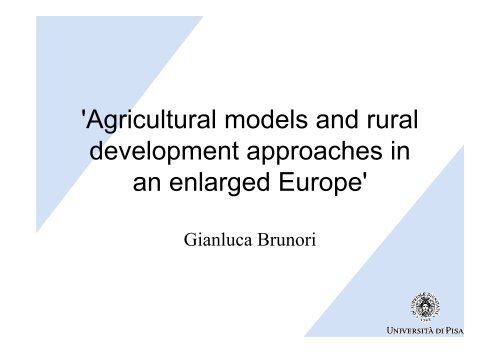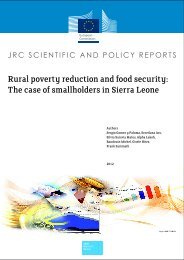'Agricultural models and rural development approaches in ... - agrilife
'Agricultural models and rural development approaches in ... - agrilife
'Agricultural models and rural development approaches in ... - agrilife
You also want an ePaper? Increase the reach of your titles
YUMPU automatically turns print PDFs into web optimized ePapers that Google loves.
<strong>'Agricultural</strong> <strong>models</strong> <strong>and</strong> <strong>rural</strong><br />
<strong>development</strong> <strong>approaches</strong> <strong>in</strong><br />
an enlarged Europe'<br />
Gianluca Brunori
Some prelim<strong>in</strong>ary remarks<br />
• European agriculture is largely shaped by<br />
the exist<strong>in</strong>g policy framework<br />
• Resources employed <strong>in</strong> agricultural <strong>and</strong><br />
related policy are enough to orient<br />
agriculture<br />
• The prevail<strong>in</strong>g visions of agriculture <strong>and</strong><br />
<strong>rural</strong> <strong>development</strong> will matter
Transition <strong>in</strong> Western Europe<br />
• Decl<strong>in</strong>e <strong>in</strong> agricultural employment,<br />
restructur<strong>in</strong>g of the food cha<strong>in</strong><br />
• New societal dem<strong>and</strong> <strong>in</strong> relation to the l<strong>and</strong><br />
<strong>and</strong> l<strong>and</strong>scape, nature <strong>and</strong> animals;<br />
• Perception of risk related to science <strong>and</strong><br />
technology<br />
• Reduction of the degree of protection
The crisis of the modernisation<br />
project<br />
• Price squeeze<br />
• Lack of alternatives<br />
• Negative externalities<br />
• Failure to stimulate the production of public<br />
goods<br />
Consumption countryside – Post-productivist<br />
agriculture
Present trends <strong>in</strong> CEECs <strong>rural</strong><br />
areas<br />
• Depopulation <strong>and</strong> age<strong>in</strong>g<br />
• Unemployment<br />
• Low level of physical <strong>and</strong> mental wealth<br />
• Lower level of education<br />
• Weak civil society <strong>and</strong> <strong>in</strong>stitutions
CEECs agriculture<br />
• Dualism (3% farms own 47% of l<strong>and</strong>)<br />
• Low productivity (30->70% EU-15)<br />
• Poor market <strong>in</strong>tegration<br />
• Poor capital endowment / Poor credit<br />
provision
Present trends <strong>in</strong> CEECs:<br />
Increas<strong>in</strong>g dualism<br />
• Town – countryside<br />
• Subsistence farms – big farms<br />
• Local – foreign agro-food<br />
New entrants/ rest of the EU?
Prevail<strong>in</strong>g policy discourses<br />
about new entrants<br />
Viable Farm structures<br />
Competitiveness<br />
Rural <strong>in</strong>frastructures<br />
Efficiency<br />
modernisation<br />
Markets
Can a model based on<br />
modernisation succeed?<br />
Can new entrants avoid the<br />
damages of modernisation?
Neo-modernisation vs<br />
modernisation<br />
Eco-conditionality<br />
Food hygiene<br />
Biotechnologies<br />
Foreign <strong>in</strong>vestments<br />
Neo - modernisation<br />
Competitiveness<br />
Viable Farm structures<br />
Markets<br />
Rural <strong>in</strong>frastructures<br />
Efficiency<br />
modernisation
The risks of neo-modernisation<br />
• Cont<strong>in</strong>u<strong>in</strong>g the cost-price squeeze<br />
• Ecological risks<br />
• Vulnerability to external shocks<br />
• Marg<strong>in</strong>alisation of poor farmers without<br />
alternatives<br />
• Dependence from the agribus<strong>in</strong>ess
Elements for alternatives to<br />
modernisation<br />
• High added value activities / new forms of<br />
cost reduction<br />
• Diversity as a resource<br />
• Embeddedness<br />
• Territorial alliances<br />
• Alternative agri-food networks
Development strategies<br />
• Neo-endogenous strategies<br />
– Cultural repertoires – symbolic capital<br />
– Synergies collective action<br />
– Selective local-global l<strong>in</strong>ks<br />
• Appropriate governance patterns –<br />
<strong>in</strong>stitutional thickness
Are these alternatives viable?<br />
• Past regimes have destroyed diversity<br />
• Isolation from the markets<br />
• The weight of subsistence production<br />
• Smaller dem<strong>and</strong> for high value added production<br />
• Poor social <strong>and</strong> <strong>in</strong>stitutional capital<br />
Need for adaptation to specific situations
Multifunctionality <strong>in</strong> the CEECs: the<br />
role of small farms<br />
• Subsistence<br />
• Employment<br />
• Resistance to shocks<br />
• Contribution to the social capital<br />
• Environment <strong>and</strong> l<strong>and</strong>scape<br />
• Cultural <strong>and</strong> biological diversity
A neo-endogenous approach to<br />
the specificities of CEECs<br />
• Focus on community <strong>and</strong> territory<br />
• Livelihood approach<br />
• Attention to external l<strong>in</strong>ks<br />
• The role of small farms <strong>and</strong> pluriactivity
Livelihood <strong>approaches</strong><br />
vulnerability<br />
assets<br />
livelihoods
Empowerment<br />
• Infrastructures<br />
• Human <strong>and</strong> social capital<br />
• Governance<br />
• Tra<strong>in</strong><strong>in</strong>g<br />
Second pillar, LEADER-like <strong>approaches</strong>
LEADER-like <strong>approaches</strong><br />
• Focus on build<strong>in</strong>g capacities<br />
• Emphasis on horizontal co-operation<br />
between <strong>rural</strong> areas<br />
• Transnational networks as learn<strong>in</strong>g devices<br />
<strong>and</strong> as tools to open new markets
Are neo-endogenous strategies<br />
compatible with the reformed CAP?<br />
• Too much emphasis on farms<br />
• Direct payments penalise small farms<br />
• Too few funds for the ‘second pillar’<br />
• Institutional weakness does not allow to<br />
profit from leader-like <strong>in</strong>tervention
Thank you!
The price squeeze
















